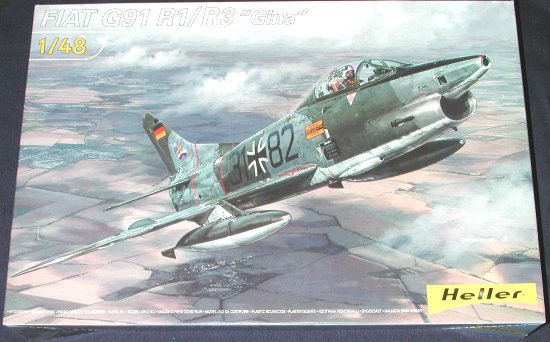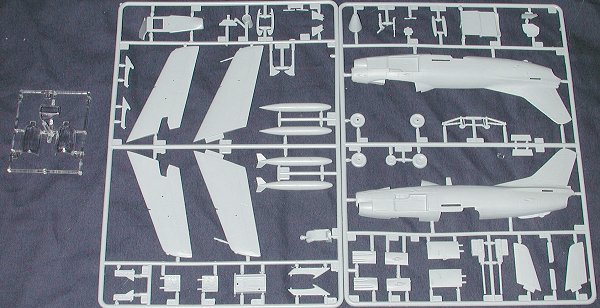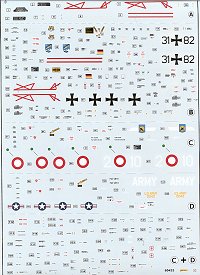
|
KIT: |
Heller 1/48 Fiat G.91R |
|
KIT # |
80433 |
|
PRICE: |
$17.98 |
|
DECALS: |
Three aircraft |
|
REVIEWER: |
|
|
NOTES: |
Ocidental mold |

|
HISTORY |
In 1953, NATO announced specifications for a light strike fighter capable of operating from rough airfields, reaching a speed of .92 mach, delivering either conventional or tactical nuclear weapons, and being simple to maintain. Fiat offered up the G-91, which was a scaled down version of the USAF F-86. While the first test flight ended with the pilot ejecting from the plane just before it crashed, the teething problems were fixed. Orders were placed with both the German and Italian Air Forces. In 1966, the Portuguese Air Force (FAP) received their first batch of G-91’s and were soon using the G-91 in combat in Africa. These aircraft served in Guinea, Mozambique, and in Angola throughout the 60’s and 70’s.
When all was said and done, lots of the
G-91’s were delivered. Italy received 174, Germany 144 and made another
294 planes under license. The FAP received 59 planes in total. Like all
great planes, their time came and all three nations eventually replaced
their G-91’s with other aircraft.
|
THE KIT |

This is the Ocidental kit repackaged by Heller. This is a good thing for us in the US as it means it is cheaper than the Ocidental version. Other than the box, instructions and decals, there is no difference at all in the kit. The kit itself is nicely done, if not a touch heavy handed in terms of panel lines. There are some areas that have sink marks, those being opposite thicker plastic on the other side of the part, such as the gun panel doors. The plastic itself is a bit thick and is soft, but nothing major. There is a touch of flash, and a few pieces have some ejector pin marks to remove.
Though nothing to write home about, the cockpit is relatively complete with
a seat, floor instrument panel and side consoles. Instruments are decals.
Wheels are a touch toy-like with no brake detail, but once installed, this
ar ea will, for all practical purposes, be invisible. There is a full gun
bay that can be displayed with the doors open, though I should mention that
only the single version actually has a gun there. The two gun option will
require the doors to be closed. Though there are two pylons under each
wing, only the inner pylon has anything for it and these are a pair of drop
tanks. I'd have though that weapons would have been included for the outer
pylons. There are two different canopies, one for the R1 variant and one
for the R3 version. The R1 version has two guns per side while the R3 has
one per side.
ea will, for all practical purposes, be invisible. There is a full gun
bay that can be displayed with the doors open, though I should mention that
only the single version actually has a gun there. The two gun option will
require the doors to be closed. Though there are two pylons under each
wing, only the inner pylon has anything for it and these are a pair of drop
tanks. I'd have though that weapons would have been included for the outer
pylons. There are two different canopies, one for the R1 variant and one
for the R3 version. The R1 version has two guns per side while the R3 has
one per side.
Instructions are well done and easy to follow Heller has a paint chart that gives a name to the Humbrol paints that are used and I do wish other companies would follow suit. The decal sheet is very large and contains marking for three aircraft. One is a German R3 from JBG 50, the next is a 2 Stormo R1, and the final is a US Army evaluation plane. All are in NATO Green/Grey uppers with aluminum undersides. The US Army one has large areas of International Orange or DaGlo on the nose, wing tips and tail. Decals themselves are quite matte and though it has been a while since I built a Heller kit, they should work well. There is also a very large stencil suite included.
|
CONCLUSIONS |
Overall, it doesn't look like a difficult kit. I'm not sure how much better it is than the old ESCI version, but at least it is newer. It does appear to need some help from aftermarket to add some detail to it, but I don't think that anything other than perhaps an Eduard etched brass set is available for it.
If you would like your product reviewed fairly and fairly quickly by a site that has over 200,000 visitors a month, please contact me or see other details in the Note to Contributors.